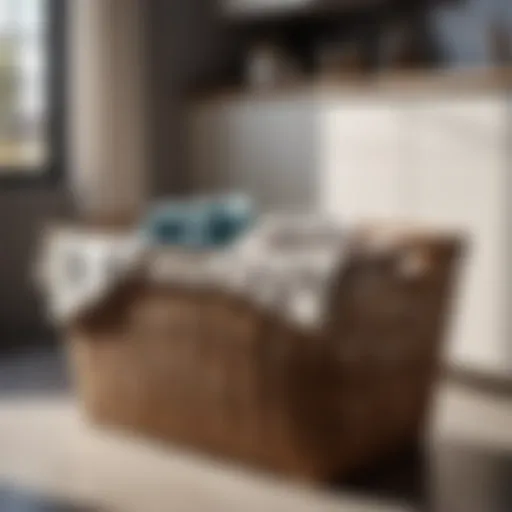The Influence of Red Drapes on Bedroom Design
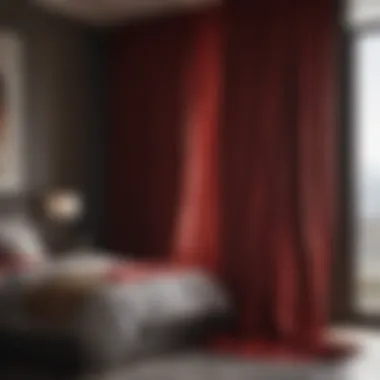

Intro
Red drapes, a statement in any setting, have the ability to change the feel of a bedroom entirely. Their rich hue can evoke a range of emotions, from passion and warmth to calm and comfort. When contemplating bedroom design, it's essential to consider how fabric choices like red drapes can enhance, or even clash, with the overall aesthetic. In this article, we dive deep into the journey of incorporating red drapes, from understanding the psychological implications to practical installation tips that ensure a beautiful outcome.
Materials:
Before embarking on this design adventure, gathering the right materials is paramount. Below is the list of essential items needed for this project:
- Red fabric for drapes: Approximately 10 yards of a medium to heavy weight fabric, such as cotton blend or sheer overlay
- Drape hooks or clips: Depending on your preference, you’ll need around 20 hooks or clips
- Curtain rod: A sturdy rod, preferably 1 to 1.5 inches in diameter, 6 feet long
- Finials: Decorative ends for the curtain rod
- Sewing machine or needle and thread if you wish to sew your own drapes
- Measuring tape: For accurate measurements
- Scissors: Sharp enough to cut fabric
- Iron: To remove wrinkles from fabric
- Pinning tools: For holding fabric in place while working
- Step ladder: For easy access to hang the drapes
DIY Steps:
Creating an atmosphere that you love starts with a well-thought-out plan. Here’s a detailed process to help you along the way:
- Measure your window: Use the measuring tape to find the width and height of the window. Add an extra 10-15 inches on each side for fullness and fall. Record these dimensions.
- Choose your fabric: Visit local fabric stores or browse online for the perfect shade of red. Consider the texture and weight of the fabric, as these factors impact how the drapes will hang.
- Cut the fabric: Once you’ve selected your fabric and have the measurements, cut the fabric accordingly. It might be helpful to smooth it out on a flat surface to avoid mistakes.
- Sew or hem the edges: If the fabric is not premade, hem the edges to prevent fraying. Use straight stitches with your sewing machine or needle and thread.
- Prepare the rod: Install the curtain rod brackets above the window according to the rod’s measurements. Make sure they're sturdy enough to hold the weight of the fabric.
- Attach the drapes: Use the clips or hooks to attach your drapes to the rod. Hang the rod on the brackets.
- Adjust and style: Play with the positioning of the drapes to achieve the desired look; whether you want them open, closed, or pulled to one side.
Technical Aspects:
Understanding the tools and timing specifics can enhance your DIY experience. Below are technical aspects that might be useful:
- Tools needed: measuring tape, scissors, sewing machine (or needle), step ladder, hammer (for brackets)
- Timing: set aside about 2-3 hours for measuring, cutting, sewing, and hanging the drapes.
- Techniques: Ensure your measurements are precise, and always double-check before cutting. If you’re hanging heavy fabric, consider using additional support brackets for the rod.
DIY Project Process:
Once the materials and plans are in place, you can dive into the actual project:
- Measure and cut the fabric as previously mentioned.
- If hemming, take your time to pin the fabric and ensure evenness along the edges.
- Before hanging, iron the fabric to eliminate any wrinkles.
- Follow the earlier steps for installation, ensuring that everything is level and secure.
- Last, stand back and admire your work. Adjust the drapes for the perfect flow and aesthetic alignment.
Troubleshooting Tips:
Design projects can be tricky, and common concerns might arise:
- Fabric not hanging evenly: Adjust the clips or hooks until the drapes appear even.
- Wrinkles remain after hanging: Use a steamer or iron while the drapes are in place; be cautious about temperature based on fabric type.
- Insufficient light: If the room feels dark, consider using a lighter shade of red or combining the drapes with lighter valances for balance.
Remember, integrating red drapes into your bedroom design is not just about aesthetics; it’s about creating a space that feels comfortable and reflects your personality.
Through careful planning and execution, you’ll find that red drapes not only enhance the design of your bedroom but may also add a touch of warmth and intimacy to your personal sanctuary.
Prolusion to Bedroom Drapery
Drapery often plays a pivotal role in the overall look and feel of a bedroom, acting not just as a functional element but also as a significant aesthetic feature. When it comes to selecting window treatments, red drapes particularly stand out for their vibrancy and emotional resonance. They can transform a space from ordinary to extraordinary, making them a hot topic in design conversations.
Why is this important? Well, in the realm of home design, every element counts. Drapes can dictate the mood of a room, influence light levels, and contribute to the feeling of comfort. When homeowners want to create a cohesive design, understanding the nuances of drapery choices becomes essential.
Importance of Drapery in Interior Design
Drapery is not merely about coverage or modesty; it's about creating an enveloping atmosphere. Think of it this way: a well-chosen drape can command attention and draw the eye toward the beauty of a room. This impact is especially true in bedrooms, where we seek comfort and tranquility.
Red drapes can be an expression of personal style. They convey warmth, passion, and a touch of drama when used correctly. On a practical note, they also offer functional benefits such as light control, energy efficiency, and privacy. Not to mention, good-quality drapery helps in insulating against heat and cold, enhancing the room's overall comfort.
Overview of Color Influence
Color in design influences both mood and perception; it's almost like a secret language that communicates emotions. Red, being one of the most intense colors, can evoke strong feelings. In a bedroom, this color choice translates to an invitation for warmth and intimacy rather than chaos.
When integrating red drapes into your decor, consider how the color associates with different styles and themes. For example, a deep crimson might suggest luxurious opulence in a more traditional setting, while a bright scarlet could say modern and bold in a contemporary space. Plus, surrounding colors play their part, too. Pairing red with muted tones can create a balanced atmosphere that is far from overwhelming.
Understanding the Color Red
In the realm of interior design, color plays a pivotal role in shaping both atmosphere and mood. Red, in particular, is a force of nature; it's a hue that commands attention and evokes powerful emotions. Understanding the color red is essential when considering its use in bedroom drapery, as it contributes not only to the room's aesthetic but also to how one feels in the space.
Red can energize a room while also imparting warmth, making it a popular choice among individuals looking to infuse their bedrooms with a sense of intimacy and liveliness. When choosing drapes, it's crucial to feel confident about how this bold color will interact with your existing furnishings and decor.
Psychological Effects of Red
The psychological impact of red is profound. It is often associated with strong emotions such as love, passion, and even aggression. In the bedroom, these attributes may translate into a dynamic and lively environment.
Research suggests that red can increase heart rates and stimulate feelings of warmth. This is particularly advantageous in spaces designed for relaxation and intimacy. Consider how couples might utilize red drapes to create an inviting atmosphere that fosters connection and closeness.
However, it's important to keep in mind that red can sometimes be overwhelming. If used excessively or in very bold shades, it might lead to feelings of anxiety or restlessness. Therefore, finding the right balance of red drapery within the bedroom is critical.
For those who want to embrace the color without turning up the emotional heat too high, opting for softer shades like brick or cherry can offer a gentler touch while still maintaining that element of warmth.
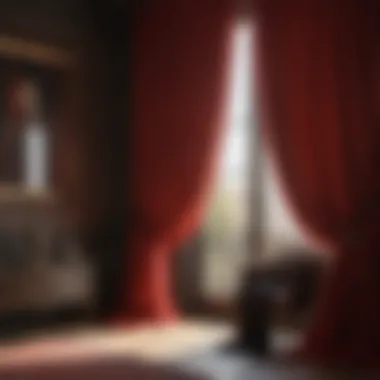

Symbolism of Red in Different Cultures
Red's symbolism varies significantly across different cultures, adding another layer to its complexity in design. In Western contexts, red often symbolizes love and passion—think of a heart-shaped box of chocolates or a romantic dinner. However, in other regions, its meaning can shift dramatically.
In China, for example, red is a symbol of good luck and prosperity. It's common to see red decorations during celebrations like weddings and the Lunar New Year, representing happiness and wealth. By integrating red drapes into a bedroom, one might not only elevate the aesthetic but also invite positive energies associated with this vibrant color.
In India, red is closely tied to weddings and traditional rites. It represents both fertility and purification, making it an important hue in various rituals. By adopting red in your drapery choices, you might find yourself drawing on these rich cultural meanings, enriching your personal living space.
Ultimately, understanding the psychological effects and diverse cultural symbolism of red can help homeowners make informed decisions that cater to their tastes and the ambiance they wish to create in their bedrooms. Choosing the right shade and integration of red drapes can transform a space, adding depth and character while resonating with the emotions and meanings you wish to convey.
Types of Red Drapes
Understanding the types of red drapes is essential for creating an impactful bedroom design. Drapes can either make or break a room's aesthetic, influencing not just the colors displayed, but also the textures and overall vibe. When selecting red drapes, various elements must be pondered, such as style, functionality, and material. Let’s explore the significance of this section further.
Curtains vs. Drapes
When it comes to the foundational choices in bedroom decor, knowing the difference between curtains and drapes is critical. Curtains are often lighter and usually come in a variety of styles that are more casual. They often frame windows without necessarily blocking out light completely. Drapes, on the other hand, are typically heavier and lined, offering better insulation and more control over light. This can be quite useful for those cozy afternoon naps or when you simply want to chase away the sun.
In small bedrooms, using drapes can create a luxurious ambiance. However, if you're working with a minimalist approach, curtains might better suit your needs as they don’t dominate the aesthetic. You should ask yourself: are you looking for something to draw the eye, or do you want your window treatments to softly accentuate the decor?
Fabric Options for Red Drapes
Choosing the right fabric is paramount when it comes to red drapery. Each fabric type brings its own set of characteristics, from the texture to the way it hangs, affecting the overall mood of the space.
Silk
Silk drapes are the epitome of elegance. This fabric is known for its luxurious sheen and smooth texture, which can imbue any room with a touch of opulence. The key characteristic of silk is its ability to capture light beautifully, offering a soft glow when the sun shines through. The unique feature of silk drapes is that they drape beautifully and create a feeling of flow in the design.
Although silk is undoubtedly a popular choice, it does come with its downsides. It can be quite delicate and requires careful maintenance. Frequent cleaning might result in fading, so homeowners need to consider where they place their silk drapes to avoid constant wear from sunlight.
Velvet
Next up is velvet, a fabric that screams comfort and absorbency. Velvet drapes can help in sound insulation, adding to the cozy nature of a bedroom. The key characteristic here is the rich texture, which provides a sense of warmth, perfect for colder climates. Velvet also lends itself well to deeper, more dramatic shades of red.
However, the downside? Velvet can be bulky and may not hang as gracefully as lighter fabrics like silk. This could be an important consideration for those with limited wall space or lower ceilings.
Polyester
Polyester is often overlooked but deserves to be mentioned because of its practicality. This fabric is not only cost-effective but also highly durable. The key characteristic of polyester is that it's easy to clean and resistant to wrinkles. Ideal for busy households, polyester drapes can maintain their shape and vibrant color over time.
Nevertheless, polyester lacks the luxurious feel of silk or the richness of velvet. It's essential to remember that while polyester can be a practical option, it might not carry the same visual impact as its more expensive counterparts, depending on what you’re aiming for in your design.
Patterns and Textures
Integrating patterns and textures is where personal style can really shine through. A variety of options sit at your fingertips.
Solid Colors
Solid colors offer a simplistic elegance. They provide a clean and contemporary look that can be used to complement other decorative elements. The key characteristic of solid red drapes is their versatility; they can fit seamlessly into both modern and traditional designs. Furthermore, solid colors can serve as a canvas for layering with other patterns in the room.
However, this simplicity might result in a lack of visual interest if not paired wisely with other decor. Careful thought is needed to ensure that the room doesn’t appear flat.
Striped Designs
Striped designs have the ability to elongate or widen a room visually, depending on orientation. The key characteristic of stripes is their dynamic quality—they can create movement and add depth. A red-striped drape could bring an element of playfulness, while still maintaining a sense of sophistication.
On the flip side, stripes can sometimes be overpowering if the pattern is too bold or too heavy. Selecting the right width and color of the stripes is crucial to achieving the desired effect without overwhelming the space.
Floral Prints
Floral prints in red tones can add a touch of whimsy and freshness to a bedroom setting. The key characteristic of floral designs is their ability to invoke a sense of nature and life. They work especially well in more romantic or vintage-styled interiors.
Yet, this approach can be quite specific; floral prints could clash with other decor elements if overused. Finding the right balance among floral patterns and other furnishings will be essential for a harmonious overall look.
By thoughtfully considering these different types of red drapes and their myriad features, you’ll be well on your way to achieving a design that speaks to your personal style and enhances the overall appeal of your bedroom.
Integrating Red Drapes into Bedroom Design
In the world of interior design, red drapes can have a significant impact on the overall ambiance of a bedroom. Integrating these bold textiles goes beyond mere aesthetics; it involves understanding the psychological effects of color, the ambiance one wishes to create, and the harmony with the rest of the decor. Red, as a color, exudes warmth and can evoke a sense of comfort and passion. Thus, how these drapes are integrated into a space becomes crucial in not only achieving visual appeal but also cultivating an emotional atmosphere.
Creating a Focal Point
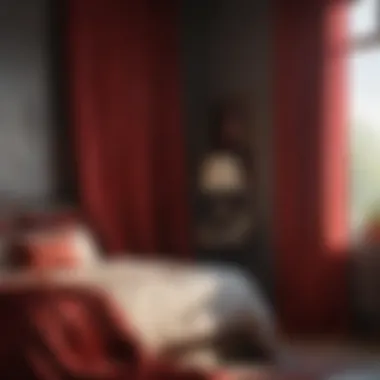

When it comes to integrating red drapes, they often serve as a stunning focal point within a bedroom. The deep, rich hue of red draws the eye, making it a prime candidate for highlighting specific areas of a room. For instance, positioning the drapes around a window bathed in natural light can create a striking contrast against softer colors in the room. This tactic not only emphasizes the beauty of the red fabric but also creates a sense of depth in the space.
A well-placed pair of red drapes can frame a view outdoors, turning a window into a picturesque scene, thereby enhancing the overall design. The key factor here is balance. Too much red, or placing the drapes without thought of their surroundings, can lead to an overwhelming effect. Therefore, consider how the red drapes interact with furniture, wall colors, and lighting to maintain a cohesive look.
Balancing with Other Colors
To make the most of red drapes, thoughtful consideration of complementary colors is fundamental. Let’s explore some effective strategies to achieve a balanced aesthetic:
Complementary Color Schemes
Complementary colors are those that are positioned opposite each other on the color wheel. In the case of red, greens are its complement. Utilizing such a scheme can create a dynamic and visually appealing environment. For bedrooms, softer greens—think sage or mint—can pair beautifully with red, making the space feel fresh and energized rather than harsh. A well-coordinated color balance contributes to a serene atmosphere, which is essential for a restful bedroom.
A key characteristic of complementary schemes is their ability to highlight each color's vibrancy, making every piece pop. This approach suits those looking for a lively yet tasteful style. However, one must tread carefully; excessive contrasts can confuse the senses.
Contrasting Elements
Introducing contrasting elements into bedroom design is another compelling method for integrating red drapes effectively. For example, placing red drapes against a pale blue wall generates a striking, energetic contrast. This method, when carefully executed, can bring dynamism into your design, preventing the bedroom from appearing stagnant. The charm of contrast lies in how it draws attention without becoming overly dramatic.
Such a layout helps in emphasizing the soft and bold attributes of each color, allowing them to coexist harmoniously. However, one challenge remains: too much contrast may lead to visual discord, so moderation is essential.
Neutrals and Earth Tones
Neutral and earth tones should not be overlooked when integrating red drapes. These colors serve as a calming anchor and provide a backdrop that allows red to shine without overwhelming the senses. Think beige, taupe, or soft browns, creating a tranquil environment while accentuating the warmth of the red fabric.
A unique feature of using neutrals is their versatility; they can transition between various trends and styles, providing durability in design choices. The main advantage? Neutrals can infuse a bedroom with serenity, establishing a peaceful retreat from daily life. That said, they can occasionally lack excitement, which red drapes beautifully counteract.
In essence, the art of integrating red drapes into bedroom design lies in the intricate balance of creating a focal point, while ensuring that the entire ensemble resonates with warmth, comfort, and style.
Practical Considerations
When it comes to bedroom design, the practical aspects of integrating red drapes cannot be overlooked. Drapery is not just for aesthetics; it plays a crucial role in how people experience a space. These considerations can have both functional and emotional impacts on the home environment. A well-thought-out approach to your drapery selections can significantly enhance comfort and style.
Light Control and Privacy
Thermal Insulation
Thermal insulation is a significant factor when choosing red drapes. It refers to the ability of the fabric to maintain your bedroom's temperature by blocking external heat or cold. When you opt for drapes made from heavier materials or those with thermal lining, they can help keep the warmth inside during cold months and cool air during the summer months. This is not just a comfort feature; it can also contribute to energy efficiency, reducing heating and cooling costs.
Some unique properties of thermal insulative drapes include their density and composition. Fabrics like polyester or a blend that includes cotton offer great thermal benefits. However, it’s important to note that while thicker materials can provide better insulation, they may limit the amount of light that filters through. Therefore, combining aesthetics with functionality becomes essential.
Blackout Options
Blackout options are another key consideration in the realm of red drapery. These specially designed curtains block out nearly all external light, making them a popular choice for bedrooms. The ability to create total darkness can be crucial for achieving good sleep quality, especially in urban settings where streetlights and activity might be disruptive.
One of the distinguishing features of blackout drapes is their layered construction, which often includes a light-blocking fabric on the back side. While this is beneficial for sleep, potential downsides include a lack of natural light during the day, which can feel stifling. Homeowners can strike a balance by combining blackout shades with lighter drapes to achieve both privacy and brightness.
Maintenance and Care
Cleaning Methods
Cleaning methods are vital to prolonging the life of red drapes and maintaining their vibrant color. Regular cleaning helps to prevent dirt accumulation and fading, which can detract from the intended aesthetic. Depending on the fabric of the drapes, maintenance may include vacuuming, spot cleaning, or even machine washing.
A unique characteristic of many modern drapery fabrics is their resistance to stains and dust. For instance, some polyester blends can be wiped clean with a damp cloth. On the flip side, natural fibers like silk may require specialized cleaning solutions or professional care, making them less convenient for everyday use.
Fabric Durability
The durability of the fabric is also a fundamental consideration in choosing red drapes. This refers to how well the material stands up to wear and tear over time. Some fabrics, like polyester, are known for their robust nature, resisting fading and damage—making them a popular choice for households with kids or pets.
Another notable feature of durable fabrics is their ability to withstand frequent washing and exposure to sunlight. However, it's essential to weigh these qualities against personal preferences and lifestyle. A beautifully lush velvet in a rich red may require more delicate care, which could deter those looking for low-maintenance options.
In the grand scheme, understanding these practical considerations regarding light control, privacy, and maintenance not only contributes to the overall functionality and longevity of red drapes but also enriches the aesthetic experience in your personal sanctuary.
Challenges of Using Red Drapes
While red drapes can add a stunning visual impact in bedroom design, they aren't without their challenges. Understanding these obstacles is crucial for anyone considering this bold choice. The vibrancy of red can either uplift a space or lead to unintended consequences if not approached thoughtfully.
One primary concern is that red drapes, depending on their intensity, can overwhelm a small or dimly lit room. This color has a strong presence and tends to draw attention, which is great if the intention is to make a statement, but can often feel like an unwelcome guest in a quiet retreat. To avoid such a situation, it's important to consider the overall dimensions and lighting of the room.
Risk of Overwhelming a Space
When incorporating red into bedroom design through drapes, one must be notably cautious. An overpowering shade can easily dominate the aesthetic, making the room feel cramped or chaotic. You might think you’re enhancing the space, but it could quickly turn into a case of too much of a good thing. Here are some crucial aspects to weigh:
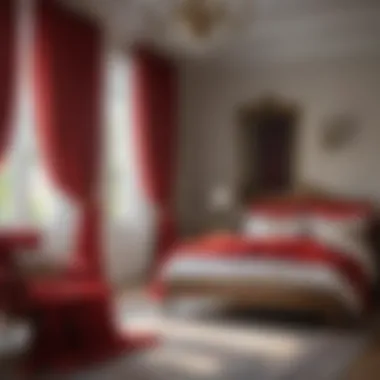

- Light Factor: The amount of natural light that enters the room plays a critical role. In spaces with limited sunlight, red drapes can create a heavier atmosphere, trapping warmth and making it feel stuffy.
- Room Size Matters: In smaller bedrooms, a heavy red fabric can visually shrink the perceived space. People may feel engulfed rather than embraced by their surroundings.
- Complementary Decor: Another consideration involves existing decor. If the furniture and wall colors are already deep or dark, introducing a bold scarlet can add visual chaos, rather than harmony.
To mitigate this risk, consider combining red drapes with lighter elements in the decor. White or soft beige bedding might tone down the robustness of the drapes and help the space breathe.
Finding the Right Shade
Selecting the perfect shade of red is akin to walking a tightrope — too dark, and you might dive into dreariness; too bright, and you face a potential distraction. It’s a balancing act that requires a keen eye for color theory and how it resonates within personal spaces. Different tones evoke varying moods, and the right shade can elevate or undermine the bedroom's atmosphere.
- Warm Reds vs. Cool Reds: Warm reds like crimson or ruby bring energy and a cozy vibe, while cooler reds with blue undertones can lend a refreshing ambience. Think about how you want to feel when you enter your bedroom.
- Testing Swatches: Always test drapes against your walls and furniture. Lighting changes throughout the day can shift the hues — what looks marvelous in the store may not translate well into your home environment.
- Personal Preference: At the end of the day, your taste should guide your decision. Choose shades that resonate with your style and existing decor to ensure your bedroom remains a sanctuary rather than a battleground of clashing colors.
In summary, navigating the challenges of using red drapes effectively requires a thoughtful approach. By considering spatial dynamics and the nuances of color, homeowners can enhance their bedrooms without falling prey to the pitfalls that this dramatic color can present.
Alternatives to Red Drapes
When considering interior design, specifically in bedroom spaces, the choice of drapery can significantly affect aesthetics and mood. While red drapes possess unique qualities that can elevate a room, it’s essential to explore alternatives. These alternatives may offer a fresh perspective or a different emotion.
Other Color Options
Choosing the right color for drapes can make or break the vibe of a room. Here are two prime categories to consider: warm hues and cool tones.
Warm Hues
Warm hues encompass colors like reds, oranges, and yellows. They have an innate friendliness that allows them to create cozy, inviting atmospheres. These colors tend to stimulate conversation and foster a sense of comfort. When thinking about warm hues for drapery, they act like a warm hug in a room, wrapping it in comforting light.
One key characteristic of warm hues is their ability to evoke energy and vibrancy. This makes them beneficial when you want to create a lively atmosphere, particularly in spaces for socializing or where family gathers, like bedrooms that double as personal retreats. However, the unique feature of warm hues lies in their duality; while they can energize, they can also overshadow softer elements, making it crucial not to go overboard.
Advantages:
- Creates warmth and intimacy.
- Encourages lively interactions.
Disadvantages:
- Risk of overwhelming the room if not balanced well.
Cool Tones
In contrast, cool tones such as blues, greens, and purples tend to offer a soothing effect. They can create an atmosphere of quiet harmony, perfect for any sanctuary, like a bedroom meant for relaxation. Cool tones are known for their calming properties, making them an excellent choice when the goal is to promote rest and tranquility.
The key characteristic of cool tones is that they often give the illusion of spaciousness. This is particularly valuable in smaller bedrooms, where a light blue or soft green can make a space feel open and airy. The unique feature of cool tones is their versatility; while they soothe the senses, they can also lend a refined elegance to a room's decor.
Advantages:
- Promotes relaxation and restful environments.
- Can create an illusion of more space.
Disadvantages:
- Might feel too cold or clinical if overused.
Accent écor Ideas
To complement any of these alternatives, selecting the right accent decor is key. Consider incorporating artwork that reflects the chosen color palette, such as framed canvas or patterned throw pillows that harmonize with your drapes. Flowers, decorative lamps, or even textured throws can infuse more personality into the bedroom.
- Consider using:
- Textile Variations: Mixing textures with knitted throws or silk cushions can add depth.
- Subtle Patterns: Whether geometric or floral, patterns can enrich the overall ambiance.
- Wall Colors: If the drapes are warm, opt for neutral walls to allow the drapes to stand out, or vice versa.
Ultimately, the right drapery will not only enhance the aesthetic appeal of the bedroom but will also shape the overall experience of the space.
When venturing beyond red drapes, remember that color isn’t just a matter of personal preference but a vast world of emotional responses and psychological effects. Engaging with these alternatives can lead you to a bedroom design that truly feels like home.
Ending
In considering the overall role of red drapes in bedroom design, it is essential to recognize their multifaceted importance. When integrated thoughtfully, these drapes can not only enhance the aesthetic appeal of a room but also influence the mood and atmosphere. Red is a color that evokes warmth and passion, setting the stage for a dynamic environment. This article has explored various dimensions of red drapery, shedding light on its psychological effects, cultural significance, and practical applications.
Summarizing Key Insights
The first major takeaway is that red drapes act as a striking focal point within a bedroom. They bring energy and vibrancy, transforming an otherwise mundane space into something lively and inviting. The careful selection of shades can dramatically affect the ambiance. For instance, a rich burgundy can instill a sense of luxury, while a bright cherry red might inject a burst of cheerfulness.
- Textural Variety
Choosing materials like velvet or silk enhances not just visual aesthetics but also tactile experiences, thereby enriching the overall environment. - Balancing Colors
Pairing red with complementary hues like soft grays, whites, or earthy tones can create a harmonious balance, making the space feel cohesive rather than chaotic.
The practical aspects cannot be overlooked either; red drapes provide utility in terms of light control and privacy, factors that are often paramount in bedroom settings. Their selection might also raise considerations regarding maintenance— understanding the fabric’s care requirements is crucial.
Final Thoughts on Bedroom Aesthetics
Ultimately, the choice of red drapes is more than just a style statement; it shapes the entire feel of the room, influencing how one interacts within that space. Homeowners and designers alike should embrace bold design choices while being mindful of potential pitfalls, such as overwhelming a room's size or causing color fatigue.
A well-executed design involving red drapes can spark conversations and invite admiration. As we wrap up this exploration, it’s clear that incorporating red into a bedroom's fabric choice allows for personal expression, connecting a space to its inhabitants in powerful ways.
"Design is where science and art break even."







